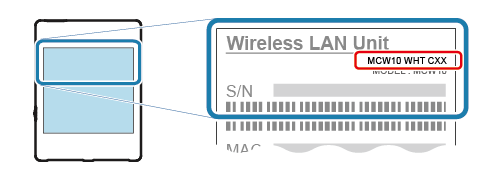Wireless Connection
The connection and operation of this product has not been verified with all wireless LAN devices, and no guarantee is provided that it will operate with all wireless LAN devices.
Caution
Handling of wireless communication functions
This product includes wireless communication functions.
The use of wireless communication may be restricted by the radio law standards of each country. Check the radio law standards of the country where the product is used and check the radio law standard acquired by the product.
- Regarding the newest information on radio laws and regulations based on which this product has been certified, see here.
- The frequency used in this product is used in a number of devices such as microwave ovens. Before use, make sure there will be no effects from radio waves emitted from these devices.
- This product has received technical standards conformity certification as a radio station for low-power data communication system according to radio laws and regulations. Therefore a radio station license is not required when using this product. However disassembly or modification of the product may be punishable by law. Do not disassemble or modify the product.
- In accordance with radio wave protection guidelines, keep a distance of 20 cm or more between the device antenna and human bodies in order to minimize the effects of exposure to electromagnetic waves. There is the risk of radio interference with and malfunction of cardiac pacemakers.
- Use of wireless devices may be restricted or prohibited in medical institutions or on airplanes.
Follow any instructions provided by each medical institution or airline company.
Wireless devices which use the 2.4 GHz band
This product uses the 2.4 GHz band.
The 2.4 GHz band is also used by microwave ovens and other industrial, chemical, and medical devices. It is also used by radio stations (license required) for identifying mobile communication in places such as factory production lines, specified low power radio stations (license not required), and amateur radio stations (license required).
- Before using this device, check that there is no premises radio station for identifying mobile communication, specified low power radio station, or amateur radio station operating in the nearby area.
- In the event that this device results in harmful radio interference with a premises radio station for identifying mobile communication, immediately change the frequency that is used or else stop radio emissions. Then take action to prevent radio interference (such as installation of partitions).
Permission for and restrictions on use
Use of MCW10 WHT C01 is permitted in the following countries.
U.S.A (US)
Canada (CA)
* Outdoor use of CH36, CH40, CH44, and CH48 is prohibited.
Use of MCW10 WHT C02 is permitted in the following countries.
Belgium (BE), Bulgaria (BG), Czech Republic (CZ), Denmark (DK), Germany (DE), Estonia (EE), Ireland (IE), Greece (EL), Spain (ES), France (FR), Croatia (HR), Italy (IT), Cyprus (CY), Latvia (LV), Lithuania (LT), Luxembourg (LU), Hungary (HU), Malta (MT), Netherlands (NL), Austria (AT), Poland (PL), Portugal (PT), Romania (RO), Slovenia (SI), Slovakia (SK), Finland (FI), Sweden (SE), Switzerland (CH), Norway (NO), Iceland (IS), Liechtenstein (LI), Turkey (TR), United Kingdom (UK), and Australia (AU)
* Outdoor use of CH36, CH40, CH44, CH48, CH52, CH56, CH60, and CH64 is prohibited.
New Zealand (NZ)
* Outdoor use of CH36, CH40, CH44, and CH48 is prohibited.
Use of MCW10 WHT C03 is permitted in the following countries.
Japan (JP)
* Outdoor use of CH36, CH40, CH44, CH48, CH52, CH56, CH60, and CH64 is prohibited.
* Check the model name from the part indicated by the red box in the illustration below (rear of the product). 
Precautions regarding security
Precautions regarding security when using a wireless LAN product
Wireless LAN performs communication between devices using radio waves instead of a network cable. As a result, while it is advantageous in enabling unrestricted LAN connections, the radio waves also reach all locations within a certain range, passing through walls and other obstructions.
If security settings are not configured, there is the risk of problems such as the following.
- Interception of communications by a third party
- Unauthorized intrusion into the network
- Leakage of information such as personal information, IDs, or card information
- Spoofing and falsification of communication data
- System or data destruction
Normally, wireless LAN cards and access points have a security system for handling these vulnerabilities, so configuring the security settings of wireless LAN products decreases the likelihood that they will be exploited.
We recommend that you thoroughly understand the vulnerabilities in using wireless LAN products without configuring the security settings, and then configure the security settings at your discretion and responsibility before using this product.
Precautions concerning SSID (Service Set Identifier) settings
When operating in access point mode, observe the following precautions in order to protect security.
- SSID
- Change the SSID from the setting at the time of factory shipment.
- Set a SSID which has as little meaning as possible so that the users cannot be identified by others.
- Encryption key
- Whenever possible, do not use terms that are listed in a dictionary.
- Use a suitable combination of meaningless numbers and symbols.